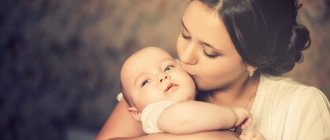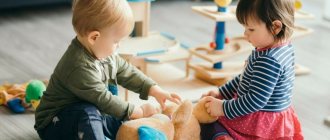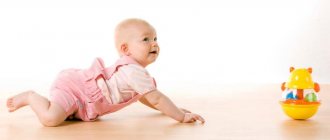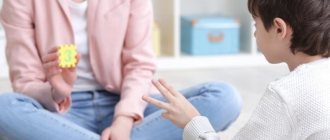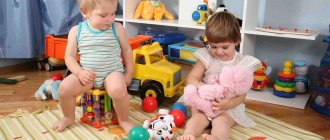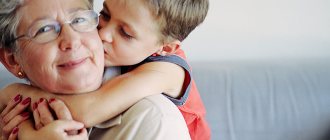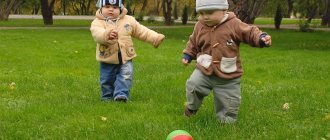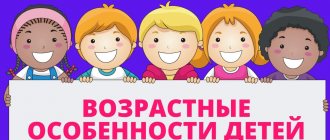Newborn crisis
The process of birth is a difficult, turning point in the life of a child. Psychologists call this period the neonatal crisis.
Causes of the neonatal crisis: - Physiological (being born, the child is physically separated from the mother. He finds himself in completely different conditions: cold, bright light, an air environment that requires a different type of breathing, the need to change the type of nutrition). — Psychological (the psyche of a newborn child is a set of innate unconditioned reflexes that help the child in the first hours of his life). What unconditioned reflexes does a newborn have? These are, first of all, breathing and sucking reflexes, protective and orientation reflexes. Some reflexes are atavistic (“catching”) - they are received from animal ancestors, are useless for the child and soon disappear. The child sleeps most of the time.
Psychological characteristics of the newborn period
The child has sensitivity: distinguishes salty, bitter, sweet taste; reacts to sound stimuli. Important events in the mental life of a child - the emergence of auditory and visual concentration
.
Auditory concentration appears at 2-3 weeks. A sharp sound, for example, a door slamming, causes a cessation of movements, the child freezes and becomes silent. Later, at 3-4 weeks, the same reaction occurs to a person’s voice. At this time, the child not only focuses on the sound, but also turns his head towards its source. Visual concentration, which appears at 3-5 weeks, is externally manifested in the same way: the child freezes and holds his gaze (of course, not for long) on a bright object. A newborn, having acquired the ability to respond to the voice of the mother caring for him, to see her face, establishes emotional connections with her. At about 1 month, the baby, seeing his mother, fixes his gaze on her face, throws up his arms, quickly moves his legs, makes loud noises and begins to smile. This violent emotional reaction has been called the “animation complex.”
The animation complex, which includes a truly human characteristic - a smile - marks the emergence of the first social need - the need for communication. And the development of a child’s need for communication means that in his mental development he moves from newbornness to infancy itself.
Emotional communication with an adult as the leading activity of an infant
The leading activity of infancy is emotional communication with adults. A child at this age is weak and completely helpless. Although, upon being born, he was physically separated from his mother, he was still biologically connected to her. He cannot satisfy any of his needs on his own: he is fed, bathed, dressed in dry and clean clothes, moved in space, and his health is monitored. And finally, they communicate with him. Such helplessness and complete dependence on an adult constitute the specificity of the social situation of an infant’s development. The need for communication in a child appears early, at about 1 month, after the neonatal crisis (according to some sources, at 2 months). The revival complex upon the appearance of the mother (or another loved one caring for the child) indicates the emergence of a need for communication, which should be satisfied as fully as possible. Direct emotional communication with an adult creates a joyful mood in a child and increases his activity, which becomes a necessary basis for the development of his movements, perception, thinking, and speech. What happens if the need for communication is not satisfied or is not satisfied enough? Children who end up in a hospital or orphanage are lagging behind in mental development. Until 9-10 months, they maintain a meaningless, indifferent gaze directed upward, move little, feel their body or clothes and do not try to grab toys that catch their eye. They are lethargic, apathetic, and have no interest in their surroundings. They will have speech very late. Moreover, even with good hygienic care, children lag behind in their physical development. These severe consequences of lack of communication in infancy are called hospitalism.
Early age (from 1 year to 3 years)
The next stage - psychological separation from the mother - begins in early childhood. This is due to the fact that the child not only develops new physical capabilities, but also intensively develops psychological functions, and by the end of the period, the initial foundations (rudiments) of self-awareness appear.
Development of mental functions. Sensitive period for speech acquisition.
Speech. By the age of 3, a child’s speech acquires a substantive meaning and, in connection with this, substantive generalizations appear. Active and passive vocabulary is growing rapidly. By the age of 3, a child understands almost everything. Speaks 1000 – 1500 words.
Perception. At an early age, other mental functions develop - perception, thinking, memory, attention. Perception dominates.
This means a certain dependence of other mental processes on it. This manifests itself - young children are maximally connected to the current situation. Their behavior is spontaneous and impulsive; nothing that lies outside the visual situation attracts them.
Until the age of 2, a child cannot act at all without relying on perception.
Elementary forms of imagination. A small child is not capable of inventing something or lying.
Perception is affectively colored - impulsive behavior. Observed objects really “attract” the child, causing him to have a strong emotional reaction. The affective nature of perception leads to sensorimotor unity. The child sees a thing, he is attracted to it, and thanks to this, impulsive behavior begins to unfold - to get it, to do something with it.
Memory. Basically, this is recognition, there is no reliance on past experience.
Actions and thinking. Thinking in this age period is usually called visual-effective. It is based on the perceptions and actions carried out by the child. And although at approximately 2 years of age the child develops an internal plan of action, throughout early childhood objective activity remains an important basis and source of intellectual development. In joint activities with an adult, the child learns ways of acting with a variety of objects.
Thinking initially manifests itself in the very process of practical activity, therefore, according to domestic psychologists, it lags behind it in terms of the general level of development and the composition of operations. The objective actions themselves are also improved. The mastered actions are transferred to other conditions.
The leading activity during this period is object-manipulative. The child does not play, but manipulates objects, including toys, focusing on the actions with them. However, at the end of early childhood, play with a plot still appears in its original forms. This is the so-called director's game, in which the objects used by the child are endowed with playful meaning. For the development of play, the appearance of symbolic or substitutive actions is important.
Emotional development. The development of mental functions is inseparable from the development of the emotional-need sphere of the child. The dominant perception at an early age is affectively colored. The child reacts emotionally only to what he directly perceives.
The child’s desires are unstable and quickly passing, he cannot control and restrain them; They are limited only by punishments and rewards from adults. All desires have equal strength: in early childhood there is no subordination of motives. The child still cannot choose or settle on one thing - he is not able to make a decision.
The development of the emotional-need sphere depends on the nature of the child’s communication with adults and peers.
In communication with close adults who help the child explore the world of “adult” objects, the motives of cooperation predominate, although purely emotional communication, which is necessary at all age stages, also remains.
A young child, when communicating with children, always proceeds from his own desires, completely disregarding the desires of others. Egocentrism. Doesn't know how to empathize. Early childhood is characterized by vivid emotional reactions associated with the child’s immediate desires.
At the end of this period, when approaching the 3-year crisis, affective reactions to the difficulties faced by the child are observed. A young child is easily distracted. If he is really upset, it is enough for an adult to show him a favorite or a new toy, offer to do something interesting with him - and the child, for whom one desire is easily replaced by another, instantly switches and is happy to do a new activity.
The development of the child’s emotional-need sphere is closely related to the emerging self-awareness at this time. At about 2 years old, the child begins to recognize himself in the mirror. Self-recognition is the simplest, primary form of self-awareness. The consciousness of “I”, “I am good”, “I myself” and the emergence of personal actions propel the child to a new level of development. The transition period begins - a crisis of 3 years.
The main lines of a child’s mental development
Sensory development: visual concentration, which appeared at the newborn stage, is improving. After the second month, concentration becomes quite long; by 3 months, its duration reaches 7-8 minutes. At this age, the child determines the shape of objects and reacts to color. The child can track moving objects. At 4 months, he not only sees, but actively looks: he reacts to what he sees, moves and squeals. A child's cognitive development is facilitated by the variety of impressions he receives. Adults caring for a child must satisfy his need for new experiences.
, trying to ensure that the environment around him was not monotonous and uninteresting. The cognitive development (primarily the development of perception) of infants living in a monotonous environment turns out to be somewhat slower than the development of those who receive many new experiences.
Development of movements and actions:
Time of occurrence of movements
| Motor development | |
| 1 month | Raises chin |
| 2 months | Raises the chest |
| 3 months | Reaches for an object, but usually misses |
| 4 months | Sits with support |
| 5 - 6 month | Grabs objects with hand |
| 7 months | Sits without support |
| 8 months | Sits down without assistance |
| 9 months | Stands with support: crawls on stomach |
| 10 months | Crawls, leaning on hands and knees; walks holding with both hands |
| 11 months | Stands without support |
| Year | Walks holding on with one hand |
1 month - chaotic movement of the hands, fingers clenched into a fist; 2 months - clenching and unclenching fingers. An object placed in the hand is held with the entire palm for 2-3 seconds. 3 months - holds an object placed in the hand for up to 10 seconds, pulls it into the mouth. 4 months - palms are often open, hands are extended towards an object, finger movements are not differentiated. 5 months - opposes the thumb to the others, parts of the fingers dominate when grasping objects. 6-7 months - the child waves the objects he has grabbed, knocks, throws and picks them up again, bites, moves from hand to hand, etc., the movements of the fingers are differentiated. 8-9 months - takes small objects with two fingers, and large ones with the whole palm, shows his nose, eyes, waves his hand when saying goodbye, tightly squeezes the toy that is taken away. 10-11 months - manipulates objects, first functional actions
, allowing for relatively correct use of objects, imitating the actions of adults (a child rolls a car, beats a drum, brings a cup of juice to his mouth).
Speech development: Already in the revitalization complex, the child shows a special interest in the speech of an adult addressed to him. In the first half of the year, speech hearing is formed, and the child himself, with joyful animation, makes sounds, usually called humming
.
In the second half of the year, babbling appears, in which it is possible to distinguish some repeating sound combinations, most often associated with the actions of the child. Babbling is usually combined with expressive gestures. By the end of 1 year, the child understands
10-20 words spoken by adults, and he himself
pronounces
one or several of his first words that sound similar to the words of adult speech.
Baby is 11 months old: what can he do?
Your baby is becoming much more independent, and there is only a month left until his first birthday. Soon you will be summing up the first results. Have you already figured out how the first celebration in your child’s life will take place? Start making your guest list and planning your holiday menu!
Physical development:
- Stands on its own;
- Walks well with one hand;
- Takes first steps;
- Bends over when lifting an object without squatting;
- Squats without support.
Psycho-emotional development:
- Gradually masters actions with objects that correspond to their purpose - puts a doll to sleep, transports loads in a car, assembles a pyramid, builds towers from cubes;
- Can name most objects in the house (in his own way);
- Uses different means to indicate his desires, in addition to crying - he moves his gaze, points with his finger, nods affirmatively or shakes his head negatively;
- Actively reacts to unfamiliar surroundings, people, or a new toy;
- Trying to spoon feed himself.
Right-handed or left-handed? If a child knows how to use a spoon, likes to draw, or collects pyramids, you have probably already noticed which hand is dominant in the baby. You can do a test: place a toy in front of the child and see which hand reaches for it first. Repeat the test regularly to see if your baby is left-handed or right-handed.
Neoplasms of infancy
New formations: elementary forms of perception and thinking. First independent steps, words. An active need to understand the world around us. With the appearance of the first words, a new stage in the child’s mental development begins. Between infancy (0-1) and early childhood (1-3) there is a transition period called the “1 year crisis”
External manifestations of a crisis: a child develops affective reactions when an adult does not understand him or forbids him to do something. The child becomes restless, manifestations of independence appear. Internal causes of the crisis: the growing contradiction between the needs for knowledge of the world around us and the capabilities that the child has. Capabilities are still insufficient to meet needs. The main acquisition of the transition period is the peculiar children's speech, which L.S. Vygotsky called it autonomous. It differs significantly from adult speech; its sound sometimes resembles “adult” words, and sometimes differs sharply from them (av-av - dog, titi - clock).
Age norms and standards are only a guideline
Remember that so many factors play a role in the development of a child that the most picky specialist will not undertake to strictly assess his maturation in the first year of life.
The period for the appearance of certain skills can be extended in time from 2 to 6 – 7 months. For example, particularly active children may try to get on their feet as early as 5 months; those who, due to their temperament, are in no hurry, may begin to show interest in such activity only at the age of one year. If you think your baby is developing some skills late, don't be afraid to talk to your pediatrician: general practitioners have a lot of experience and knowledge about all the normal variations.
You can be sure that if from the first days of his life the child ate well and slept, was in the fresh air, received a sufficient amount of physical and emotional stimuli, was surrounded by the love and care of adults, was examined on time by a pediatrician and specialized specialists - to his On his first birthday he grew into a beautiful, healthy and happy baby!
List of used literature:
- Kazmin A.M., Kazmina L.V. Diary of child development from birth to three years. - Moscow: Publishing House "Cogito-Center", 2008.
- Lisina M.I. Communication, personality and psyche of the child. - Voronezh: Publishing house NPO "MODEK", 1997.
- Mukhina V.S. Child psychology. - Moscow: Publishing House "Prosveshchenie", 1985.
- White B. The first three years of life. - Moscow: “Pedagogy”, 1982.
